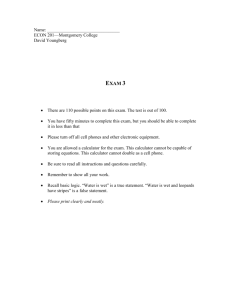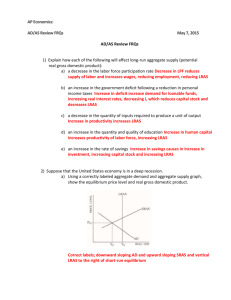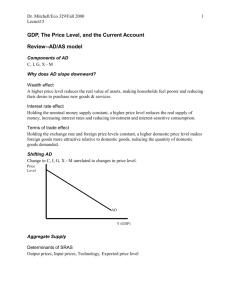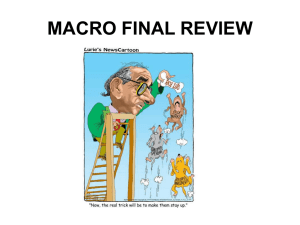3.1a
advertisement
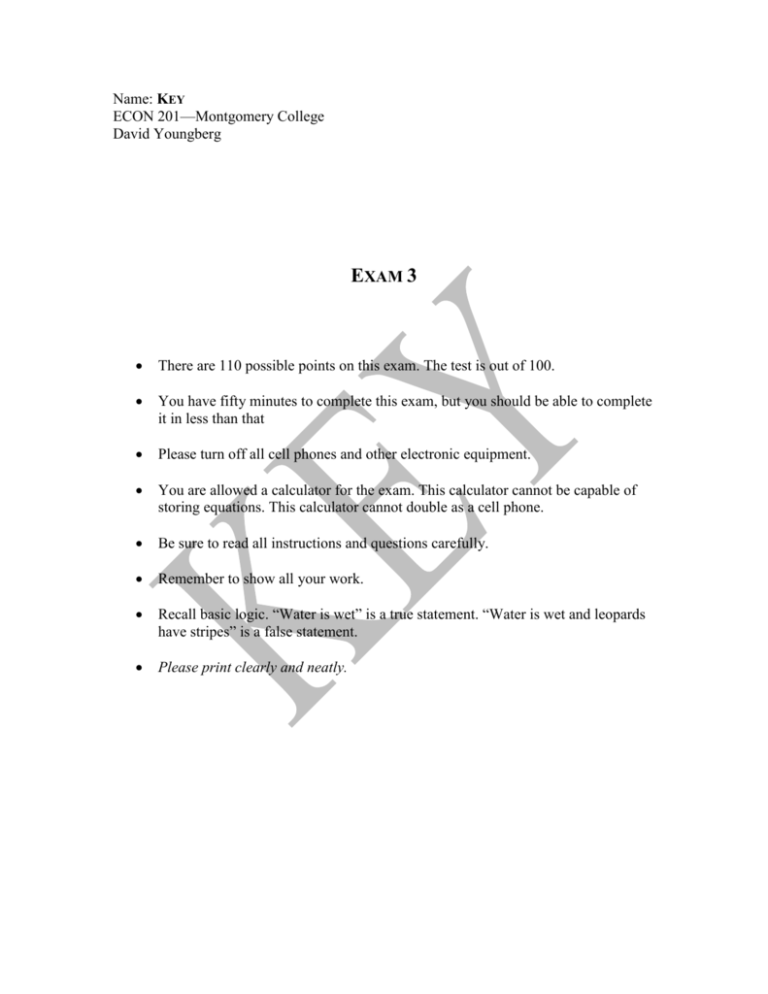
Name: KEY ECON 201—Montgomery College David Youngberg EXAM 3 There are 110 possible points on this exam. The test is out of 100. You have fifty minutes to complete this exam, but you should be able to complete it in less than that Please turn off all cell phones and other electronic equipment. You are allowed a calculator for the exam. This calculator cannot be capable of storing equations. This calculator cannot double as a cell phone. Be sure to read all instructions and questions carefully. Remember to show all your work. Recall basic logic. “Water is wet” is a true statement. “Water is wet and leopards have stripes” is a false statement. Please print clearly and neatly. Part I: Matching. Write the letter from the column on the right which best matches each word or phrase in the column on the left. You will not use all the options on the right and you cannot use the same option more than once. 2 points each. 1. 2. 3. 4. 5. 6. 7. H Aggregate demand D Automatic stabilizer C Marginal propensity to save A Monetary multiplier E Real shock (negative) F Real shock (positive) I Short run aggregate supply A. B. C. D. E. F. G. H. I. Bigger of this means a bigger shift Cannot be less than one Cannot be greater than one Example: Food stamps Example: Hurricanes Example: Human capital increases Example: Social Security Shifts if car prices increase Shifts if raw material prices increase 1. If car prices increase, people’s nominal wealth increases (similar to if housing prices increase), thus they will consume more and AD shifts right. 2. When recession hits, more people are eligible for food stamps; government spending increases without any explicit act of Congress. 3. MPS is the portion of additional income that goes to savings. It cannot be greater than one because your additional savings cannot be greater than your additional income. 4. The monetary multiplier determines how far AD shifts when monetary policy; if the multiplier is large, total additional borrowing will be very high when real interest rates fall. 5. A negative real shock would mean the economy, on a fundamental level, produces less. Since hurricanes destroy the capital stock on a massive scale, this natural disaster is a good example of a negative real shock. 6. A positive real shock would mean the economy, on a fundamental level, produces more. More human capital means people are more productive so this would certainly suffice. 7. Raw materials are a kind of input; if input prices increases, SRAS, and not LRAS, shifts left. Part II: Multiple Choice. Choose the best answer to the following. 4 points each. 8. One can argue the internet made prices less sticky. Which of the following would clearly be a logical explanation for this? a. Consumer expectations are less likely to change b. c. d. e. Menu costs are lower Contracts last a longer amount of time A&B None of the above Menu costs, or the cost associated with changing a price, are clearly a little lower. The process of literally changing the price on, say, Amazon is functionally zero as it’s just a matter of changing a couple of lines of computer code. This does not mean all internet-related menu costs are zero—there are other costs to consider besides changing the menu such as market research and advertising—but it certainly reduces it and thus makes it less sticky. Neither (A) nor (C) are correct. Option (C) would make prices stickier (it’s also not clear why the internet would change how long contracts last). While the internet would alter consumer expectations (people can shop around easier), it would probably make them more fluid, not less. Here, the direction of stickiness matters: consumers are willing to accept a lower price but expectations means they are loathe to accept a higher price (even if it’s paired with a higher wage). So, again, Option (A) is likely to make it stickier, not less sticky. 9. If the reserve requirement (aka reserve ratio) is 20% and the MPS is 0.1, what is the monetary multiplier? a. 1.25 b. 5 c. 10 d. 20 e. None of the above The monetary multiplier is found by dividing the reserve requirement/ratio by 1. 1 / 0.2 = 5; MPS plays no role concerning the monetary multiplier. 10. Some individuals argue that fractional reserve banking is inherently unstable. Suppose we did away with fractional reserve banking, setting the reserve requirement (aka reserve ratio) to 100%. How would this change alter the effectiveness of open market operations? a. It would completely eliminate any effectiveness b. It would significantly hinder its effectiveness c. It would have no change on its effectiveness d. It would enhance its effectiveness e. It is impossible to tell with the information provided With 100% reserve requirements, the monetary multiplier drops to 1. That means money created by the Fed doesn’t get multiplied nearly as much. If the Fed buys government securities from banks then that money can be lent out (because such funds are not subject to reserve requirements) but it won’t be lent out again. There will be a small drop in interest rates, but not much. AD will shift right a little, but it not very far. 11. Consider the fictional island nation of Mepos, where fishing is the main industry. The government uses a progressive tax system much like the United States. For taxable incomes up to $20,000, the marginal tax rate is 10% and 20% beyond that. If a fisherman makes $50,000 in taxable income, how much does he owe in taxes? a. $5,000 b. $8,000 c. $10,000 d. $12,000 e. None of the above This progressive tax system works off of marginal rates. For the fisherman, the first $20,000 he makes is taxed at 10% ($2,000) and the rest of his income ($30,000) is taxed at 20% ($6,000). Thus the total tax owed is $8,000. 12. In the short-run, _____ prices are stickier than _____ prices. a. Input; output b. Output; input c. Import; export d. Export; import e. None of the above Because contracts keep input prices static, input prices are stickier than output prices (though menu costs and consumer expectations keep both of them sticky). 13. If the U.S. dollar becomes less valuable, what happens in the U.S. economy? a. AD shifts b. LRAS shifts c. SRAS shifts d. A & B e. A & C AD shifts right as the U.S. dollar’s value drops because imports are more expensive and exports become less expensive. As a result, real GDP will rise. SRAS shifts left because the higher import prices means higher input prices. LRAS does not change at all. 14. Which of the following tax policies would act as an automatic stabilizer? a. An annual tax of $50 from each person. b. An annual 10% tax to the value of all owned jewelry. c. An annual 15% tax on all incomes. d. A & C e. None of the above Though the tax is directly proportional—it’s fixed at a certain percent— because wealthy people are more likely to own jewelry and are more likely to own a lot of jewelry, the tax is functionally progressive (though difficult to enforce). When times are bad, one would expect people would buy less jewelry and sell off what jewelry they have. Thus they would not be taxed on it and the tax burden, relative to income, would fall. Option C is what’s called a flat tax: tax burden relative to income doesn’t change. Option A is the opposite of a progressive tax, called a regressive tax. The poorer you are, the great the burden this tax is. 15. Which of the following is an example of adverse selection? a. Buying a laptop you know won’t work. b. Voting for an honest politician who then uses his influence unethically. c. Adopting a dog who turns out to have a bad temper. d. A & C e. None of the above Only option C is adverse selection; the dog didn’t become bad because you chose her. It always had a bad temper; you just didn’t know it. Option B is moral hazard: the politician was honest but then the opportunities presented by his position incentivized him to become corrupt. Option A isn’t anything but stupid. If you know the laptop doesn’t work, why are you buying it? Recall both adverse selection and moral hazards are examples of asymmetric information; there is no asymmetric information here. 16. Which of the following would cause the U.S. AD to shift right? a. The government spends more, funded by increasing taxes. b. Incomes in China, Europe, and other countries fall due to a recession. c. Scientists discover a new energy source which can be implemented immediately. d. A & B e. None of the above Option A has no net effect: government spending shifts AD right but increasing taxes shifts it left. Falling incomes abroad would cause AD to shift left, not right. Option C would cause a rightward shift but of LRAS— because a new energy source would alter the fundamentals of production— not AD. None of these would cause AD to shift right. 17. Economists often debate the size of the fiscal multiplier, particularly when there’s a recession. What is the significance of this debate? a. A large fiscal multiplier means unemployment will stay high. b. A large fiscal multiplier implies there will be a lot of inflation. c. A large fiscal multiplier ensures fiscal policy will be very effective. d. B & C e. None of the above Larger multipliers mean a small increase in government spending shifts AD very far. If the cause of the recession is a drop in AD, then Option C is correct but that relationship is not guaranteed; a recession could be caused by a real shock. If it is caused by a real shock, Option B is correct: inflation will follow and the price level will rise farther if the multiplier is large. 18. Which of the following would cause both LRAS and SRAS to shift right? a. The price of oil falls b. New technology which fixes genetic flaws (e.g. Down syndrome) in fetuses c. Interest rate falls d. A & B e. None of the above As an input, falling price of oil will shift SRAS right and might cause a temporary boost, but a change in prices doesn’t shift LRAS. Only real shocks shift LRAS. A falling interest rate would shift AD as it encourages investments. Option B would shift LRAS right but not SRAS. Removing genetic abnormalities from fetuses won’t pay off any time soon. It won’t when they’re born, when they’re toddlers, etc. It will pay off when they grow up, however, and we’ll really see these numbers as productivity grows. You could also argue that LRAS won’t shift right, either. After all, the full employment isn’t changing now; it’s changing much later. It really boils down to what you consider “long-run.” Admittedly, this is quite long-run. 19. What is the federal funds rate? a. The rate banks borrow from the Fed. b. The rate banks borrow from each other. c. The rate banks buy government securities from the Fed. d. The rate banks buy government securities from each other. e. None of the above Option A is the discount rate. The federal funds rate is how overnight interest rate banks charge each other. Part III: Short Answer. Answer the following. 16 points each. 20. Briefly explain how the Federal Reserve engages in monetary policy using its most commonly used tool. (Make sure to identify what this tool is called in your answer.) The Fed’s most commonly used tool for monetary policy is open market operations. The Fed begins by creating money and then using this money to buy government securities from commercial banks. With more reserve, the federal funds rate falls and the money supply increases. With more money for loans available, interest rates fall and investment rises. AD shifts to the right (based on the monetary multiplier) and real GDP increases. When the Fed sells government securities, money is taken out of the system. This increases interest rates and reduces inflation; AD shifts left. 21. Consider the AD-AS diagram of an economy below. Illustrate the effect of (1) a terrible drought which affects most of the country, (2) expansionary fiscal policy in response to that drought, and (3) the long-run effect of that policy. You should label each shift to make the order clear. PL LRAS’ SRAS’ LRAS SRAS (1) (2) (3) (1) AD’ AD’’ YR A major drought is a real negative shock; thus the LRAS and the SRAS shift left. If the government attempts to correct this shock through fiscal policy, AD will shift right, causing a small increase in real GDP and price level in the short run. In the long run, however, crowding out will shift AD back. 22. Consider the AD-AS diagram of an economy below. Illustrate the short and long run effects of a drop in the real interest rate due to an increase in the money supply. You should label each shift to make the order clear. PL LRAS SRAS’ SRAS (2) (1) AD’ AD YR A fall in real interest rates causes AD to shift to the right as borrowing for consumption and investment increases. Because there is a lot more money floating around in the economy, this increase isn’t crowded out by a fall in something else (say, other kinds of consumption or government spending). Otherwise, AD wouldn’t move at all; it would shift out and in at the same time. The economy is now in an inflationary gap; with the competition for resources, input prices increase, causing SRAS to shift left. Note this is an illustration of demand-pull inflation.
